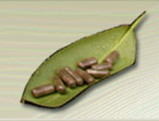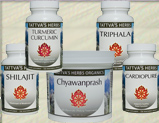 Loading... Please wait...
Loading... Please wait...Providing 25 Years Of Premium Service
Storewide Sale - Save 20%
Blog - history of turmeric
Turmeric – History and traditional uses
Posted on 9th Dec 2009
Curcuma longa L. (fam. Zingiberaceae), also known as turmeric, was highly esteemed by the ancient Indo-European people, for its golden-yellow dye resembling sunlight. This culture known as Arya, worshipped the solar system and attributed special protective properties to those plants, which like turmeric, contained sun-colored yellow dyes.
Turmeric, best known as “Haridra” in Sanskrit, has a rich history in India and has been used for centuries in the Ayurvedic1,2,3,4,5 system of medicine. It can be identified by forty-six synonyms such as Pita “yellow”, Gauri “brilliant” and all other words which signify “night”1. The reference to “night” may be derived from tradition which required that married women apply turmeric on their cheeks in the evening, in anticipation of a visit by Goddess Lakshmi, at that time. This custom, still practiced in some parts of India, is probably a remnant of an ancient sun-worship tradition. The brilliant-yellow color of turmeric, which is resistant to very high dilutions, found its way to commercial use as a coloring agent for various items including cotton, silk, paper, wood, foodstuffs and cosmetics.
Turmeric became of special importance to man with discovery that its powdered rhizomae when added to various food preparations preserved their freshness and nutritive value. Turmeric which belongs to a group of aromatic spices, was originally used as a food additive in curries to improve storage conditions, palatability and presentation of food. Long before the time of cheaper synthetic food preservatives, spices like turmeric played a vital role as food additives and were valued more than gold and precious stones.
In Ayurveda, turmeric has been used internally as a stomachic, tonic and blood purifier, and topically in the prevention and treatment of skin diseases1,2,3,4,5. Half to one gram, twice a day was given for flatulence and dyspepsia. It has been prescribed in liver diseases, and particularly for jaundice, and urinary tract diseases. In chronic catarrh and coryza, the inhalation of the fumes of burning turmeric causes copious mucous discharge and gives instant relief. Boiled with milk and sugar, turmeric has been a traditional remedy for colds. Turmeric and alum powder in the proportion of 1 to 20 is applied into the ear in chronic otorrhea. Turmeric has been described as useful in skin diseases, e.g. juice of the fresh rhizome is used in parasitic skin infections, turmeric powder rubbed down with oil has been applied to rough skin. In combination with lime and saltpetre turmeric has also been applied to bruises, sprains, wounds, infected wounds and inflammations. In pemphigus (an allergic and inflammatory skin condition) and shingles, after a thick coat of mustard oil is applied, turmeric powder is sprinkled to alleviate pain, inflammation and to promote healing. In small-pox and chicken pox a coat of turmeric is applied to facilitate the process of scabbing. Mixed with borax as a paste, turmeric is applied to reduce tissue swelling due to inflammation. A decoction of turmeric is prepared (1 ounce of turmeric to 20 ounces of water) as a cooling eyewash and is applied as a lotion to relieve burning in purulent ophtalmia known in India as “country sore eye”.
© Sabinsa Corporation 2000















